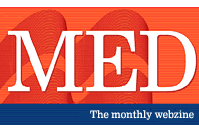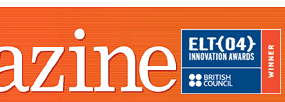|

FROM THE EDITOR
 In
this Issue In
this Issue
 Contributors Contributors
 Letters
to the Editor Letters
to the Editor
 Write
to Us Write
to Us
 Spread
the Word Spread
the Word
 Back
Issues Back
Issues
 Index Index
 Register Register
FEATURE
 Introducing the New Edition
of the Macmillan English Dictionary
Introducing the New Edition
of the Macmillan English Dictionary
COLUMNS
 British and American culture
British and American culture
Email and text messages
 New
words of the month
New
words of the month
Spending can seriously damage your wealth –
new words and finance
 MED
Profile MED
Profile
Interview with Michael Rundell
 Your questions answered
Your questions answered
|
 |
by Michael
Rundell
•
The success of the first edition
• Why a second edition?
• What the second edition
has on offer
• Core vocabulary
• Improvements
• Innovations
The Macmillan English Dictionary (MED) was
published at the beginning of 2002, and quickly gained a reputation
for quality, innovation, and user-friendliness. The development of the
MED was guided by two key principles: firstly, a belief that we can
make dictionaries better by applying what we learn from linguistic theory
in practical ways; and secondly, a commitment to ‘learning from
learners’ – in other words, finding out what students and
teachers really need their dictionaries for, and then tailoring the
dictionary to meet those needs.
This proved a successful formula, and the MED has won
several prestigious prizes, including the ESU
English Language Book Award (2002) and the British Council’s
ELT
Innovation Award (2004).
top
So why do we need a new edition? Well, the world hasn’t stood still
since we produced the first MED. The English language is in a state
of continuous change, as it responds to social, political, and technological
developments. Our understanding of how languages work and how people
learn them continues to improve, and – thanks to new technology
– the resources available to us for studying languages (large corpora
and intelligent software) have become bigger and better.
All of this gives us the means to make the dictionary
even more relevant to the needs of its users. So our first job was to
get a clearer idea of what these needs are. As well as talking to hundreds
of teachers, language-teaching experts, and students of English, we
conducted a massive survey of MED users. Almost 2,000 people took part,
and they told us what they liked about the MED, what could be improved,
and what additional features would make the dictionary even more helpful.
We analysed the results, and the new MED has been specially designed
to reflect what users told us.
top
Like its predecessor, the new MED focuses on three main aspects of the
language-learning process:
- receptive tasks: understanding what
you read and hear
- productive tasks: writing and speaking
natural English, accurately and with confidence
- language awareness: developing a
deeper understanding of the language system as a basis for successful
learning
To achieve all this, we have built on the innovations
we introduced in the first edition, which included:
- menus to help users find the right
meaning fast
- collocation boxes listing words
that frequently occur together, to help users write natural-sounding
English
- metaphor boxes that reveal the
connections between all the words and phrases we use for expressing
particular ideas and emotions
- language awareness articles, written
by well-known experts, on topics ranging from Pragmatics to British
and American English
- learning support through the MED’s
dedicated website
and this monthly
magazine. These provide tips on using the dictionary, a regular
‘new words’ column, e-lessons for teachers, articles by
leading language experts, and much more
top
The most important feature of all is the clear distinction that the
MED makes between high-frequency core vocabulary and
the less common words needed mainly for reference.
Core vocabulary – the words you need to know in order to perform
successfully in both receptive and productive modes – is shown
in red, and reference items – the more specialized,
less frequent words – are shown in black. There
are 7,500 ‘red words’ in the MED, and research
into users’ vocabulary needs has convinced us that this is an appropriate
and realistic target for learners who want to succeed at advanced level.
This key feature of the first MED remains unchanged in the new edition.
top
In every other area we have made improvements and additions. There are
many more collocation boxes in the new MED, and more collocates listed
in the existing ones. We have added 20 new metaphor boxes, because users
told us this was one of their favourite features. And there is a complete
set of new Language Awareness articles written specially for this edition.
top
In addition, the new MED provides improved resources for users’
receptive and productive needs. On the receptive side, we have added
hundreds of new words and phrases that have appeared in the last five
years, and our coverage of World English has almost doubled. Two other
‘receptive’ aids are worth a special mention. First –
as a direct response to the results of our user survey – we have
added about 4,000 items of specialist vocabulary, with
a focus on six key subject areas: business and economics, science, information
technology, medicine, tourism, and the arts.
Meanwhile, the dictionary’s CD-ROM includes thousands
of weblinks. This means that – whenever users
want more in-depth information about a cultural, historical, literary,
or political issue – they can just click on an icon, and they will
be taken to a carefully-selected website that tells them everything
they need to know.
But the most important innovations are on the ‘productive’
side. The new MED has a special focus on writing skills, and includes
a range of materials designed to help learners produce written texts,
especially in academic or professional settings. These materials have
two aspects:
- vocabulary enrichment: the MED now
includes extensive vocabulary expansion material in three important
areas: Communication, Emotions, and Movement. In
addition, the MED’s CD-ROM now has a thesaurus
as well as a dictionary, so that users who are looking for a better
way of expressing an idea can just click on the thesaurus icon, and
they will be given a range of appropriate vocabulary.
- writing skills: working with the
Centre for English
Corpus Linguistics (CECL) at the University
of Louvain in Belgium, we have produced a complete set of materials,
based on an extensive learner
corpus, to help learners using English in an academic or professional
context. These include 18 major sections devoted to developing writing
skills such as Exemplifying and Reformulation, and
over 100 special notes for helping learners avoid common errors. The
MED CD-ROM also has exercises to enable users to practise what they
have learned. This unique feature – the product of a two-year
research project – makes the MED the best resource for anyone
who needs to write essays or reports in accurate, well-structured
English.
Finally, I would like to thank everyone who has contributed
to the new edition of the dictionary, above all our talented editorial
team and our distinguished advisory panel who have worked so hard to
keep up the MED tradition of technical and linguistic innovation and
academic excellence.
For an interview with Michael Rundell, Editor-in-Chief
of the Second Edition of the Macmillan English Dictionary,
visit this page.
top |





